Menu
Math Lesson 14.4.3 - Perpendicular Lines
Please provide a rating, it takes seconds and helps us to keep this resource free for all to use
Welcome to our Math lesson on Perpendicular Lines, this is the third lesson of our suite of math lessons covering the topic of Parallel, Perpendicular and Intersecting Graphs, you can find links to the other lessons within this tutorial and access additional Math learning resources below this lesson.
Perpendicular Lines
Since we have not yet explained the concept of perpendicular lines in geometry, it is not worth trying to analytically "extract" any rules that integrate the elements of these two lines in the same formula, as we have done in previous cases. Therefore, at this stage of the course, we will explain how two perpendicular lines relate to each other through a numerical example.
First, let's explain what the term "perpendicular" means. Thus, two perpendicular lines (or segments) are intercepting lines (or segments) that form four right angles between them, as shown in the figure below.
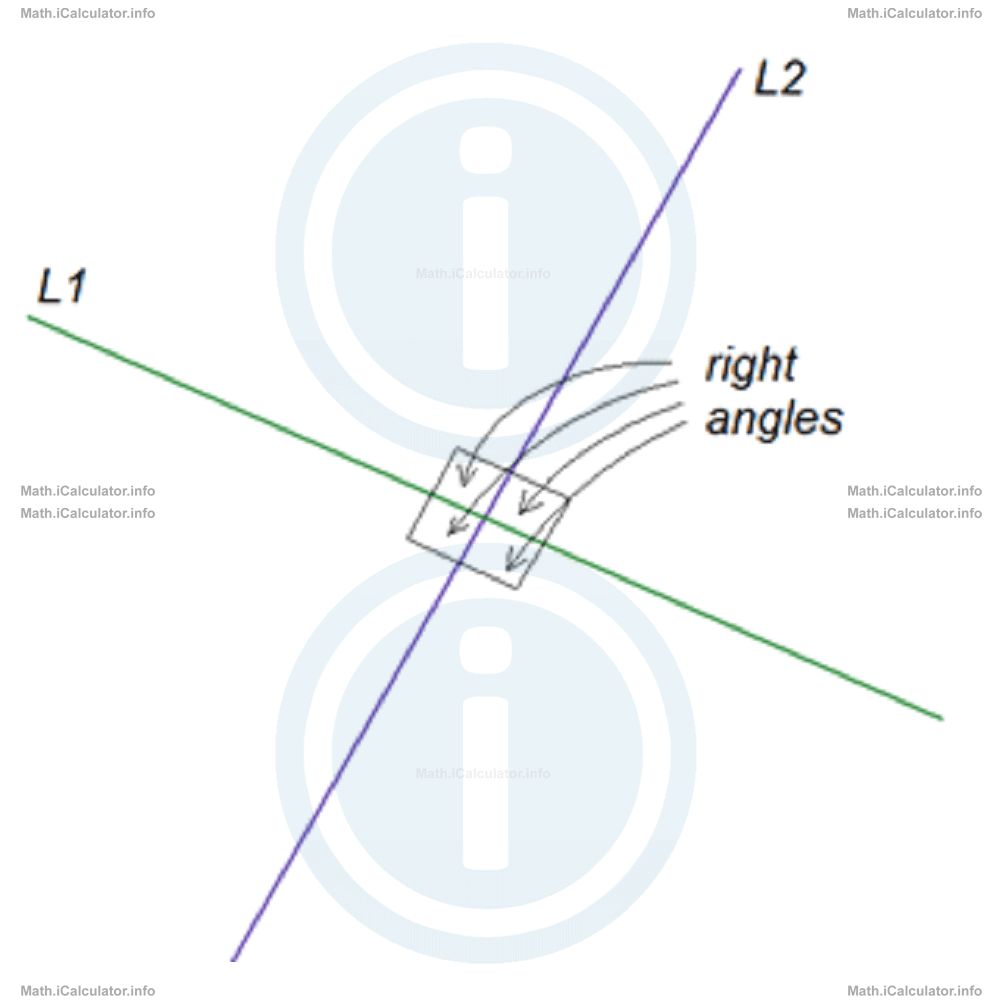
The coordinate plane is the most outstanding example of perpendicular lines, where the two axes are perpendicular to each other. Indeed, the horizontal direction is perpendicular to the vertical one and vice versa.
Let's suppose that initially, we have two perpendicular lines: x = 0 and y = 0 that obviously extend according the X- and Y-axes respectively, as shown in the figure.
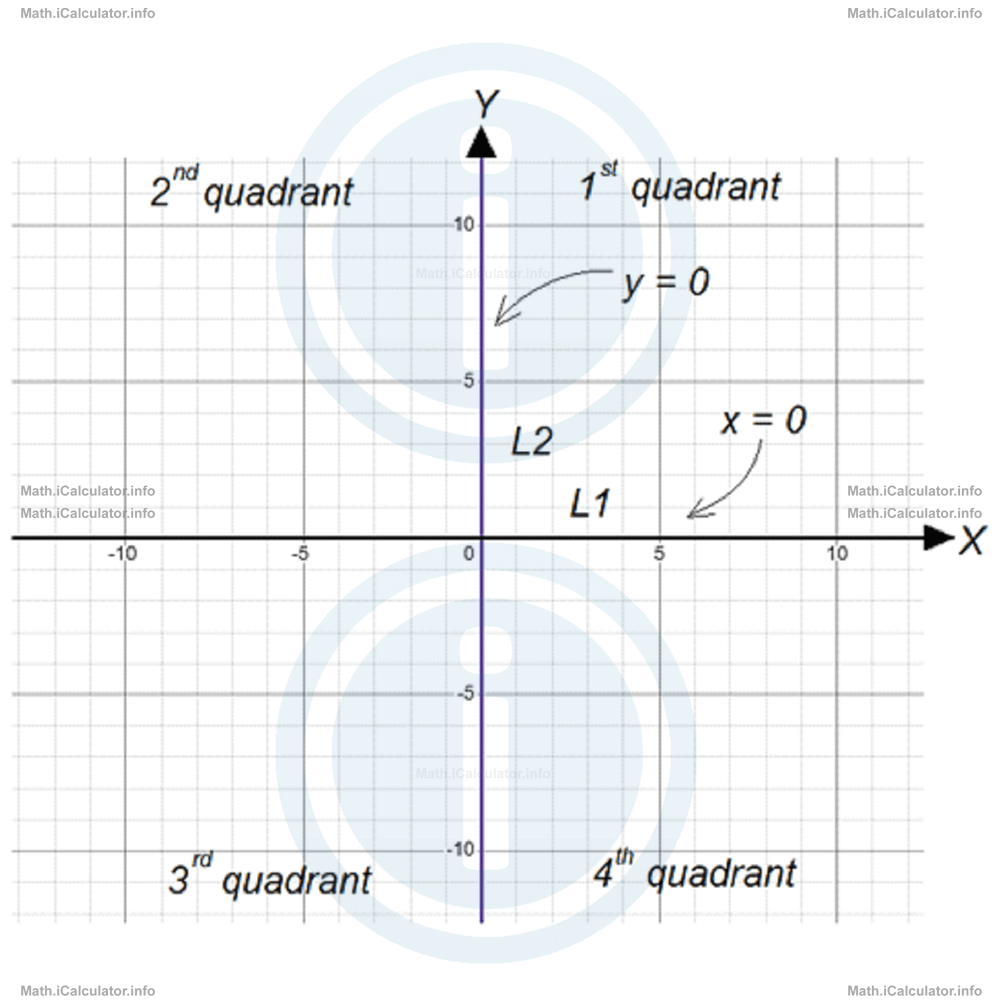
It is evident that the two lines divide the plane (the flat surface where they lie) into four equal regions. In the coordinate system, these regions are known as "quadrants." Thus, the upper right region (where both x and y are positive) is known as the 1st quadrant; the upper left region (where x is negative and y is positive) is known as the 2nd quadrant; the bottom left region (where both x and y are negative) is known as the 3rd quadrant; and the bottom right quadrant (where x is positive and y is negative) is known as the 4th quadrant.
Now, let's rotate the two graphs by 1/8 of a rotation anticlockwise. Obviously, they still will be perpendicular to each other. The former horizontal line now will be sloped and will divide the 1st and the 3rd quadrants into two equal regions each. On the other hand, the former vertical line will do the same thing in the 2nd and the 4th quadrants, as shown below.
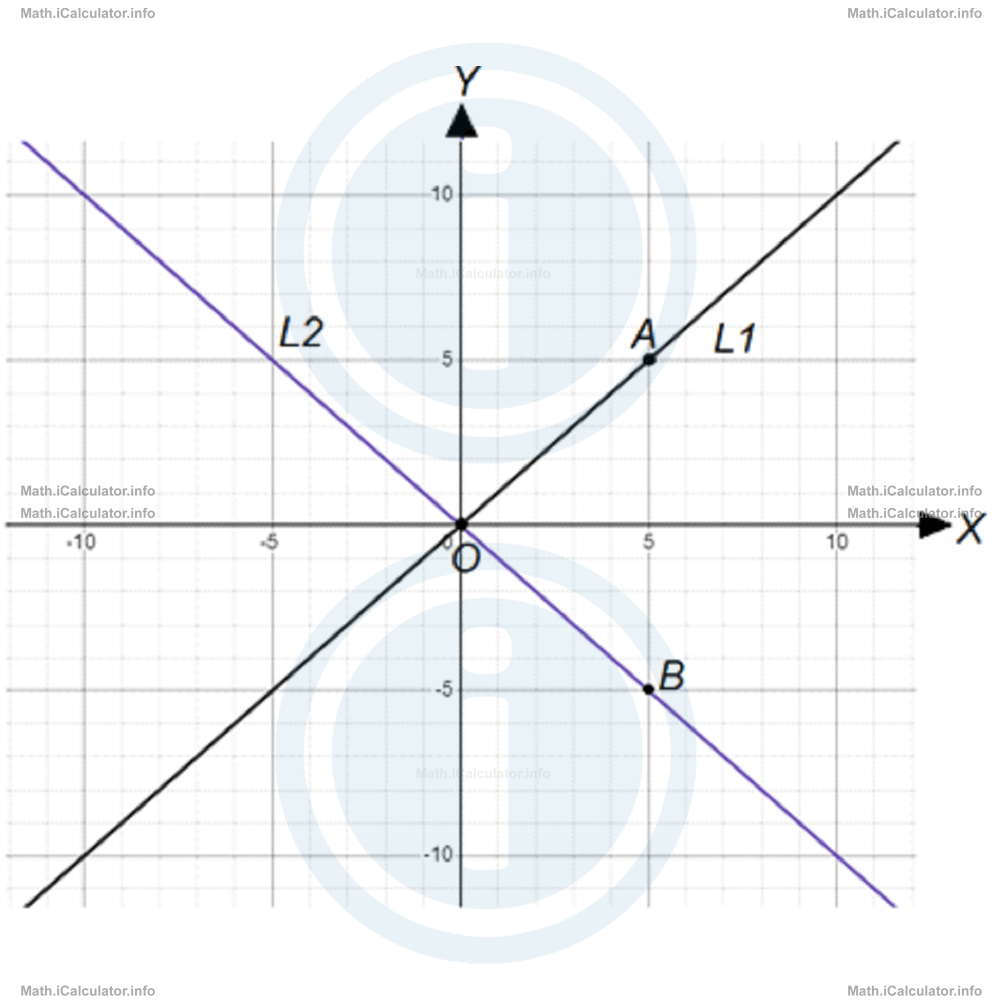
Let's find the equations of the new lines obtained by such a rotation. The first thing that you will notice for lines L1 and L2 is that both of them pass through the origin, i.e. their x- and y-intercepts are zero. Therefore, both lines have the constant n = 0 and one of the points necessary to plot the graphs is the origin O(0, 0). The other two points could be for example A(5, 5) for L1 and B(5, -5) for L2, as shown above.
Using the equation of gradient for the line L1 yields
= 5 - 0/5 - 0
= 5/5
= 1
and the gradient of the line L2 is
= -5 - 0/5 - 0
= -5/5
= -1
The equation of L1, therefore, is y = 1x (or y = x) and that of L2 is y = -1x (or y = -x).
In this way, we obtain two gradients with opposite signs. This occurs in all perpendicular lines. But, is there any formula that relates the two gradients with each other? For now, it is still unclear what kind of relationship the gradients of L1 and L2 have, as there is more than one option possible. We don't know yet whether the relationship between gradients in perpendicular lines is m1 + m2 = 0; m1 · m2 = -1; m1/m2 = -1, and so on.
Well, to answer this question, we need to consider another pair of perpendicular lines. Thus, if originally we have two points A and B - one for each graph - with coordinates, say, A(0, 10) and B(10, 0) and we shift the graphs in such a way to make point A appear at (-4, 10) and B at (10, 4), we obtain again two perpendicular lines, as shown in the figure.
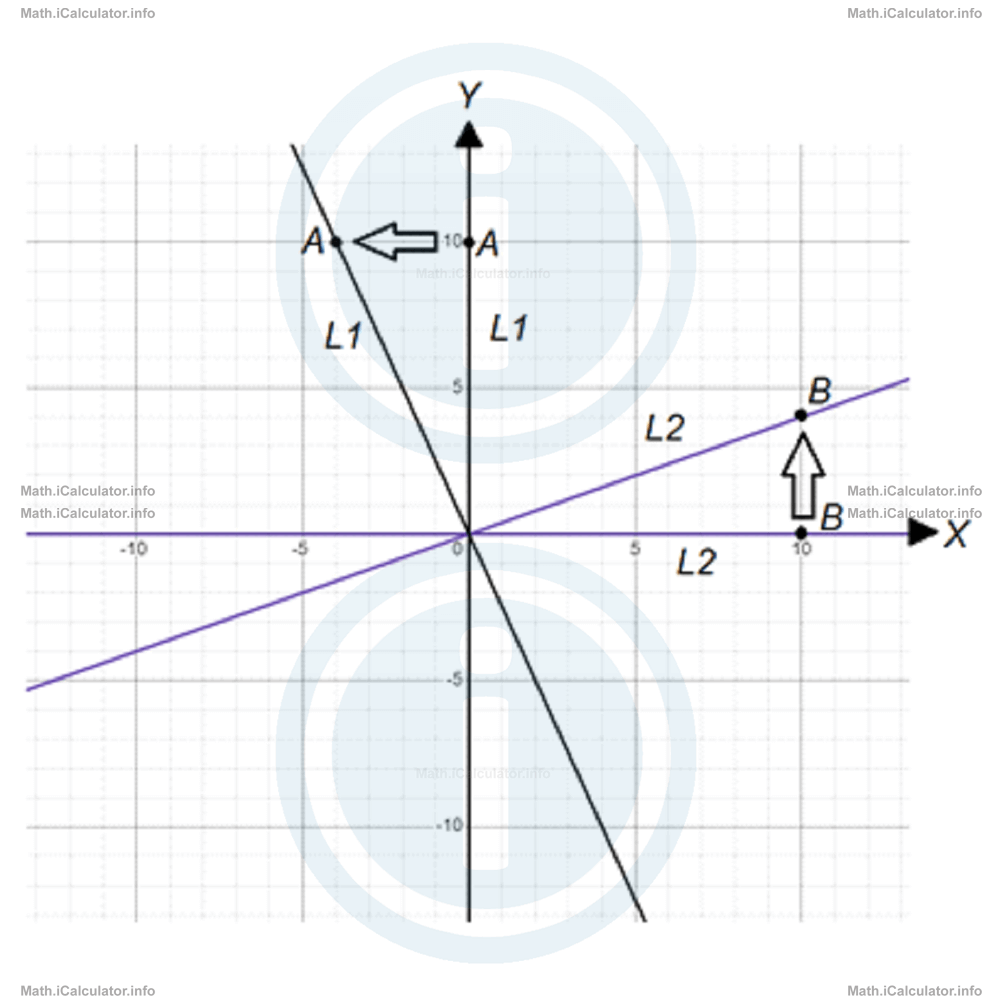
We did all this to be sure that we still got two perpendicular lines L1 and L2. Now, let's find the equation of each (new) line using the two points A and B and the origin O(0, 0). Thus, the gradient of the new line L1 is
= 10 - 0/-4 - 0
= -10/4
= -5/2
and the gradient of the line L2 is
= 4 - 0/10 - 0
= 4/10
= 2/5
Now, it is easy to identify the relationship between the gradients m1 and m2 of the two given perpendicular lines. Multiplying the two gradients yields
= -10/10
= -1
This is true for all pairs of perpendicular lines. For example, in the previous pair of perpendicular lines, where m1 was 1 and m2 was -1, we obtain
= -1
In this way, we obtain the rule that gives the relationship between the gradients m1 and m2 of perpendicular lines:
Example 3
- Find the perpendicular line to y = 3x - 1 that passes through point A(4, -5)
- Plot the two graphs in the same coo
Solution 3
- The gradient m of the line y = 3x - 1 is m1 = 3. Therefore, the gradient of the unknown line perpendicular to it is m2 = -1/3 because, from theory, we know that m1 ∙ m2 = -1Thus,3 ∙ m2 = -1This means that so far, the known part of the equation of the perpendicular line to y = 3x - 1 is
m2 = -1/3y = -1/3 x + nTo find the value of n, we substitute the coordinates of point A, since it belongs to this line. Thus, for x = 4 and y = -5 we obtain-5 = -1/3 ∙ 4 + nHence, the equation of the perpendicular line to y = 3x - 1 that passes through A(4, -5) is
-5 = -4/3 + n
n = 4/3 - 5
= 4/3 - 15/3
= -11/3y = -1/3 x - 11/3 - We can use the coordinates of x- and y-intercepts for the two lines to plot the graph. This allows us check the solution made in (a). Let's find these points by filling the table below.
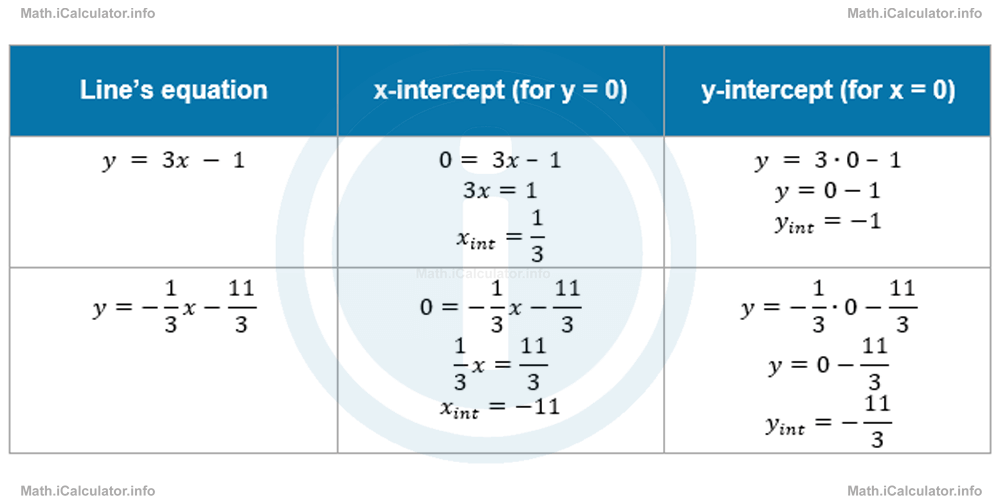 Therefore, points P(0, -1) and Q(1/3, 0) are intercepts for the line y = 3x - 1, while points R(-11, 0) and S(0, -11/3) are intercepts for the line y = -x/3 - 11/3. The figure below shows both lines in the same graph.
Therefore, points P(0, -1) and Q(1/3, 0) are intercepts for the line y = 3x - 1, while points R(-11, 0) and S(0, -11/3) are intercepts for the line y = -x/3 - 11/3. The figure below shows both lines in the same graph. 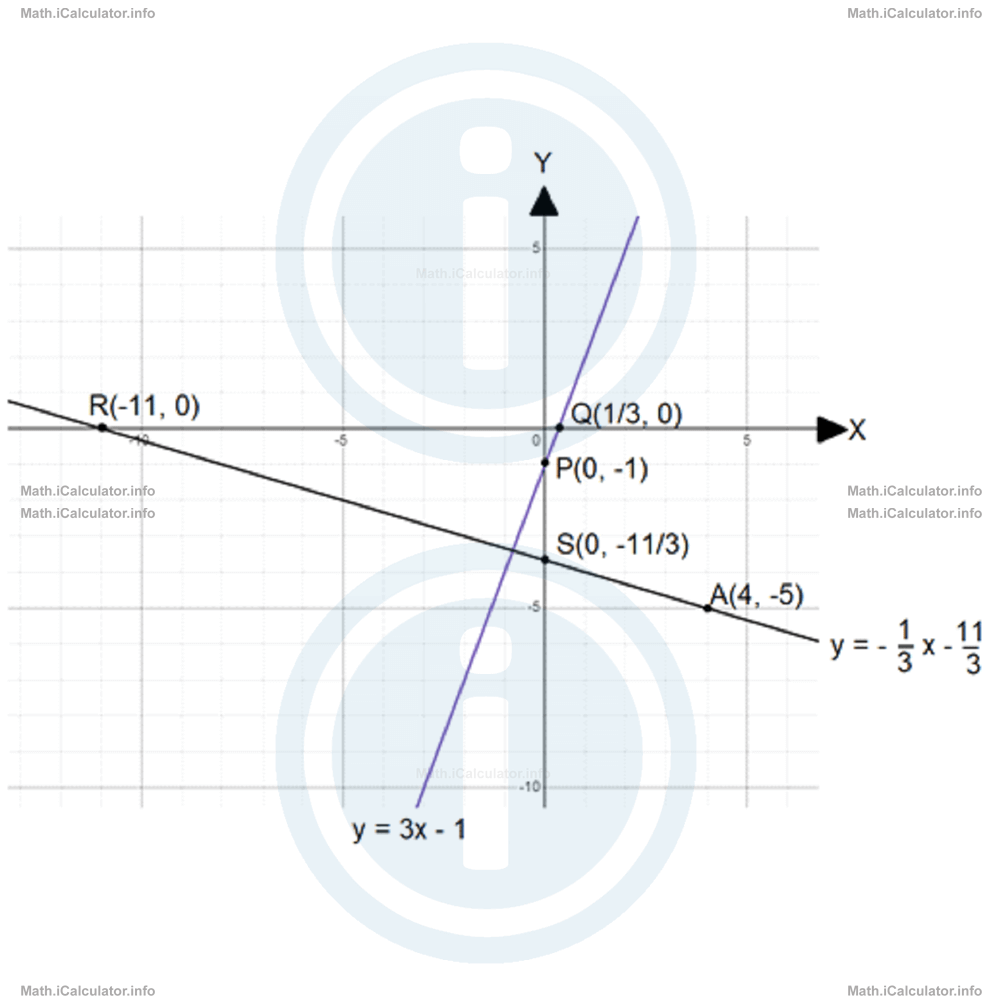 The graphs confirm the results obtained in the analytical form, as it is evident that the two lines are perpendicular.
The graphs confirm the results obtained in the analytical form, as it is evident that the two lines are perpendicular.
More Parallel, Perpendicular and Intersecting Graphs Lessons and Learning Resources
Whats next?
Enjoy the "Perpendicular Lines" math lesson? People who liked the "Parallel, Perpendicular and Intersecting Graphs lesson found the following resources useful:
- Perpendicular Feedback. Helps other - Leave a rating for this perpendicular (see below)
- Linear Graphs Math tutorial: Parallel, Perpendicular and Intersecting Graphs. Read the Parallel, Perpendicular and Intersecting Graphs math tutorial and build your math knowledge of Linear Graphs
- Linear Graphs Revision Notes: Parallel, Perpendicular and Intersecting Graphs. Print the notes so you can revise the key points covered in the math tutorial for Parallel, Perpendicular and Intersecting Graphs
- Linear Graphs Practice Questions: Parallel, Perpendicular and Intersecting Graphs. Test and improve your knowledge of Parallel, Perpendicular and Intersecting Graphs with example questins and answers
- Check your calculations for Linear Graphs questions with our excellent Linear Graphs calculators which contain full equations and calculations clearly displayed line by line. See the Linear Graphs Calculators by iCalculator™ below.
- Continuing learning linear graphs - read our next math tutorial: Line Segments
Help others Learning Math just like you
Please provide a rating, it takes seconds and helps us to keep this resource free for all to use
We hope you found this Math tutorial "Parallel, Perpendicular and Intersecting Graphs" useful. If you did it would be great if you could spare the time to rate this math tutorial (simply click on the number of stars that match your assessment of this math learning aide) and/or share on social media, this helps us identify popular tutorials and calculators and expand our free learning resources to support our users around the world have free access to expand their knowledge of math and other disciplines.